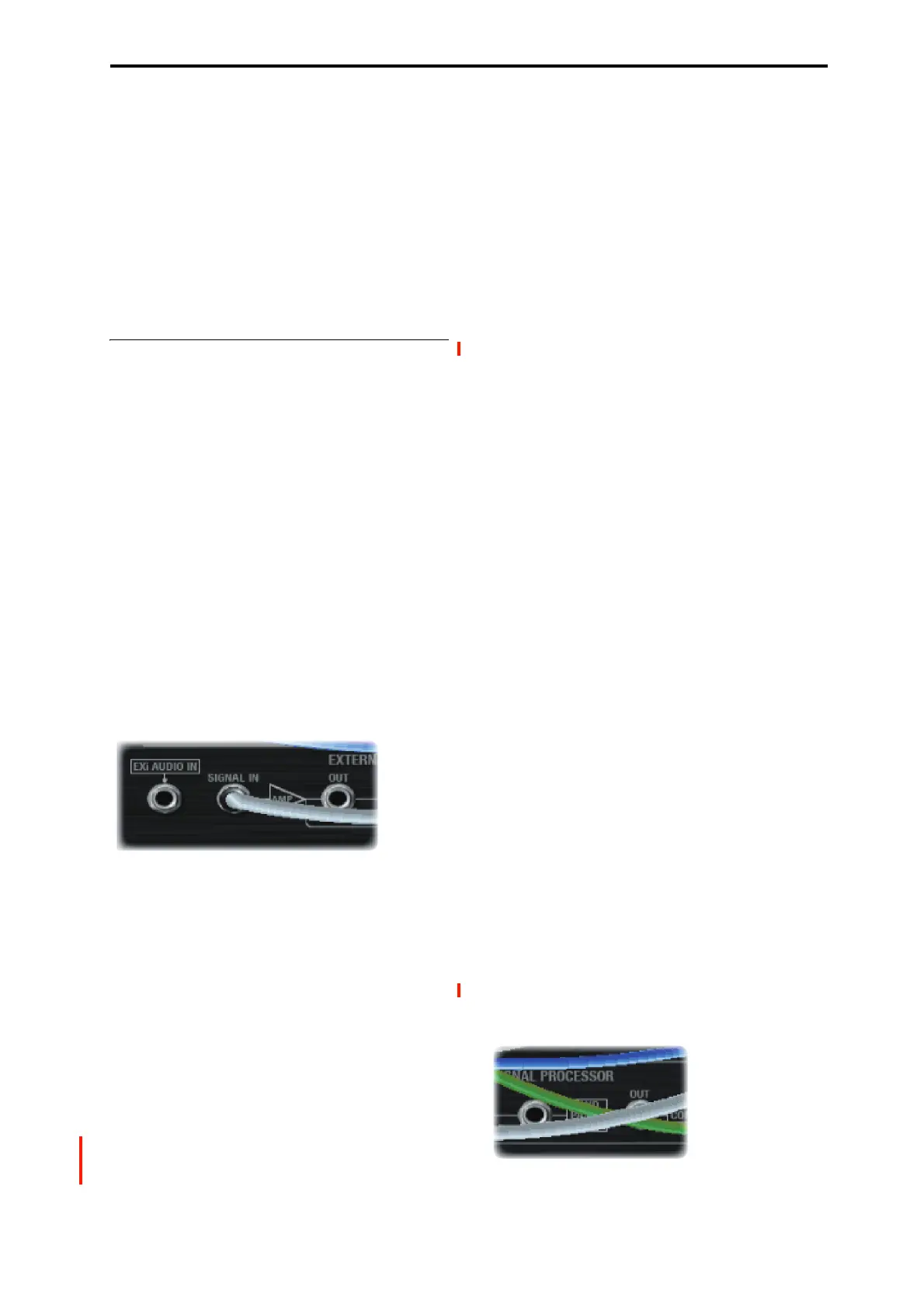PROGRAM > MS-20EX: Patch Panel 6–1: Patch Panel
273
MIXER 2
This is a second 2-in, 1-out mixer, identical to “MIXER 1,”
above.
IN A jack
This is the first input to the mixer.
IN B jack
This is the second input to the mixer.
OUT jack
This is the merged output of IN A and IN B.
6–1k: EXTERNAL SIGNAL PROCESSOR
(ESP)
Important: the ESP is only active when notes
are played
The ESP can process live audio inputs, feedback from
effects, or any other audio from within the NAUTILUS–as
well as audio from within the MS-20EX itself. Note,
however, that the ESP is only active when a voice is being
played on the MS-20EX.
It’s easy to make a patch in which only the incoming audio is
heard, with the built-in VCOs completely silent–but you still
need to press a key (or play a note via MIDI) in order to
activate the MS-20EX. You can use the EXi Common Hold
parameter to keep the note “held down” indefinitely, if you
like.
For more information, see “Using the External Signal
Processor (ESP)” on page 274, and “Tip: Creating self-
triggering patches” on page 269.
Audio Inputs
EXi AUDIO IN jack
This mono input lets you route audio from elsewhere in
NAUTILUS through the MS-20EX. You can use any of the
audio inputs, any of the audio outputs, the REC buses, the
FX Control buses, or the outputs of any of the Insert, Master,
or Total Effects.
You can also route live or recorded audio through the MS-
20EX, in real-time–and we’re sure that you’ll be able to
think of other creative uses!
The audio input source and channel (left, right, or L+R
summation) are selected by the Input Source and Channel
parameters in the current Program, Combination Timbre, or
Song Track.
For more information, see “4–2: EXi Audio Input” on
page 134 (PROGRAM mode), “2–6: EXi Audio Input” on
page 412 (COMBINATION mode), and “2–6: EXi Audio
Input” on page 487 (SEQUENCER mode).
Once you’ve selected the desired audio source, you can
connect the EXi AUDIO IN jack to any input on the Patch
Panel. For instance, you can route the audio through the
HPF, LPF, or BPF, mix it with the built-in VCOs and noise
generator, and so on. You can also use the ESP to convert the
audio to a trigger or CV source, as described under “Using
the External Signal Processor (ESP),” on page 274.
The EXi AUDIO IN is monophonic, but you can use two
MS-20EX together to process stereo signals:
1. Create a double EXi Program, and assign both EXi1
and EXi2 to use the MS-20EX.
2. In the EXi Audio Input parameters, assign the left
channel to EXi1, and the right channel to EXi2.
3. Pan the output of EXi1 to the left, and the output of
EXi2 to the right.
Note: In the Legacy MS-20 plug-in, the audio input is
normalled to the HPF’s Ext Signal Input. To enable more
flexibility in patching, this signal is not normalled in the MS-
20EX. When converting sounds from the Legacy plug-in,
the EXi audio input should be patched to the Ext Signal In
jack.
SIGNAL IN jack
This is the input to the External Signal Processor. To use this
with live audio input, connect the EXi AUDIO IN jack to
the SIGNAL IN jack.
SIGNAL LEVEL knob [0.00…10.00]
This adjusts the volume of the signal connected to the
SIGNAL IN jack.
This knob has over 50dB of gain at the maximum setting of
10.00. Unity gain (+0dB) is at 3.75; 5.00 is about +4dB, and
7.50 is about +12dB.
If the input level is high, setting above unity gain will cause
increasing amounts of saturation and overdrive, creating a
more aggressive tone.
(SIGNAL) OUT jack
This is the signal from the SIGNAL IN jack, scaled by the
SIGNAL LEVEL control.
BAND PASS FILTER
The Bandpass filter includes separate controls for high and
low cut, and passes through only the audio between those
two frequencies. It’s normalled to the input of the
Frequency-to-Voltage converter, for fine-tuning the
incoming audio.
You can also use this filter to process audio signals, or to
sculpt the Noise Generator’s output for particular
modulation effects. You can even use it as a third filter for
the VCOs, in addition to the HPF and LPF.
Note: Even at the widest settings for high and low cut, there
will still be some attenuation of the highest and lowest
frequencies.

